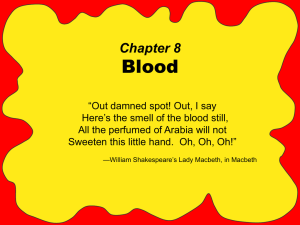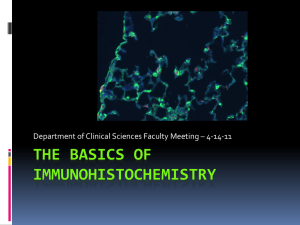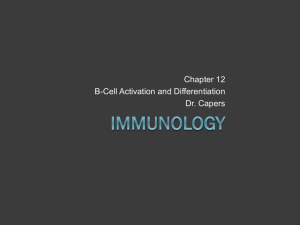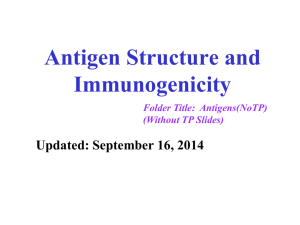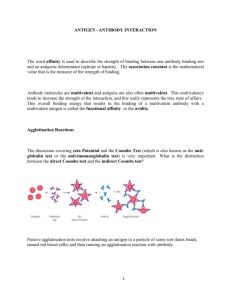Immuno Chapter 7 [4-20
advertisement
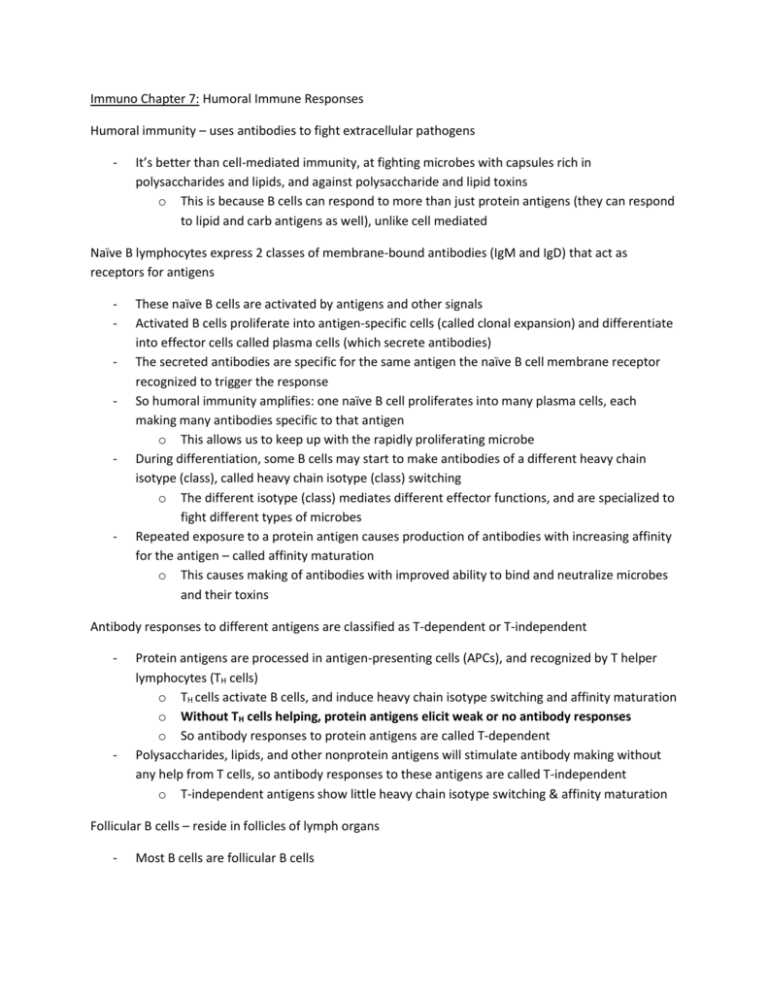
Immuno Chapter 7: Humoral Immune Responses Humoral immunity – uses antibodies to fight extracellular pathogens - It’s better than cell-mediated immunity, at fighting microbes with capsules rich in polysaccharides and lipids, and against polysaccharide and lipid toxins o This is because B cells can respond to more than just protein antigens (they can respond to lipid and carb antigens as well), unlike cell mediated Naïve B lymphocytes express 2 classes of membrane-bound antibodies (IgM and IgD) that act as receptors for antigens - - - These naïve B cells are activated by antigens and other signals Activated B cells proliferate into antigen-specific cells (called clonal expansion) and differentiate into effector cells called plasma cells (which secrete antibodies) The secreted antibodies are specific for the same antigen the naïve B cell membrane receptor recognized to trigger the response So humoral immunity amplifies: one naïve B cell proliferates into many plasma cells, each making many antibodies specific to that antigen o This allows us to keep up with the rapidly proliferating microbe During differentiation, some B cells may start to make antibodies of a different heavy chain isotype (class), called heavy chain isotype (class) switching o The different isotype (class) mediates different effector functions, and are specialized to fight different types of microbes Repeated exposure to a protein antigen causes production of antibodies with increasing affinity for the antigen – called affinity maturation o This causes making of antibodies with improved ability to bind and neutralize microbes and their toxins Antibody responses to different antigens are classified as T-dependent or T-independent - - Protein antigens are processed in antigen-presenting cells (APCs), and recognized by T helper lymphocytes (TH cells) o TH cells activate B cells, and induce heavy chain isotype switching and affinity maturation o Without TH cells helping, protein antigens elicit weak or no antibody responses o So antibody responses to protein antigens are called T-dependent Polysaccharides, lipids, and other nonprotein antigens will stimulate antibody making without any help from T cells, so antibody responses to these antigens are called T-independent o T-independent antigens show little heavy chain isotype switching & affinity maturation Follicular B cells – reside in follicles of lymph organs - Most B cells are follicular B cells - Follicular B cells are mostly T-dependent, class-switched, and high affinity antibody responses to protein antigens, and give rise to long-lived plasma cells Marginal zone B cells – found in marginal zones of the spleen white pulp, they respond to carb antigens in the blood B-1 B cells – respond to nonprotein antigens in the mucosal tissues and peritoneum Marginal zone and B-1 B cells have antigen receptors that have limited diversity in what they recognize, and do mostly IgM responses, which lack most of the features of T-dependent antibody responses Less antibody is produced after the first encounter with an antigen (primary response) than in future encounters (secondary response) - With protein antigens, secondary responses also show increased heavy chain class switching and affinity maturation, because repeated stimulation by the protein antigen ↑ the # of TH cells Figure 7-3 page 134 – table of differences between primary and secondary antibody response Humoral immune responses are initiated when antigen-specific B cells in the spleen, lymph nodes, and mucosal lymph tissues, recognize antigens - Some microbe antigens get transported to and concentrated in B cell-rich follicles and marginal zones of peripheral lymph organs In lymph nodes, macrophage lining the subcapsular sinus may capture antigens and display them to B cells in nearby follicles B cells specific for an antigen use their immunoglobulin (Ig) receptors to recognize the antigen o This triggers B cell activation o A second signal is also needed When a B cell sees it’s antigen, it’s membrane Ig receptors cluster together, triggering signals that are transduced by receptor-associated signaling molecules - Two or more receptor molecules need cross-linked to transduce the signal, which happens when they see more than one antigen molecule, or one antigen molecule with multiple epitopes Nonprotein antigens often have many identical epitopes in each molecule, allowing them to bind to many Ig receptors on a B cell at the same time Signals initiated by antigen receptor cross-linking get transduced by receptor-associated proteins o IgM and IgD have very variable antigen binding regions, but can’t transduce signals So the Ig receptors attach to 2 proteins called Igα and Igβ, to form the B cell receptor (BCR) complex o The cytoplasmic domain of Igα and Igβ have immunoreceptor tyrosine-based activation motifs (ITAMs) o So when antigen receptor clusters form, the tyrosines in the ITAMs get phosphorylated by kinases associated with the BCR complex o - The new phosphotyrosines then become docking sites for adapter proteins, which then also get phosphorylated, allowing them to recruit signaling molecules The signal is then sent to activate transcription factors that will turn on genes that code for products involved in B cell proliferation & differentiation – page 136 – pic of signal transduction B cells also have a receptor for a complement protein, to be the second signal to activate the B cell - - When the complement system is activated by a microbe, the microbe gets coated with breakdown products of C3 complement protein (the most abundant complement protein) o Includes breakdown product C3d, which B cells have a receptor for, called type 2 complement receptor (CR2 or CD21) So an antigen on the microbe is the 1st signal, & complement (from innate immunity) is the 2nd signal Microbe products that engage B cell toll-like receptors (TLRs) can also trigger activation o Dendritic cells are B cells with lots of TLRs Activated B cells proliferate into antigen-specific clones, and may start to make and release IgM - - - This response is greatest when the antigen is multivalent, cross-links many antigen receptors, and activates complement strongly o T-independent antigens (nonproteins) trigger strong responses this way Most protein antigens don’t have multiple identical epitopes, so they can’t cross-link that many receptors on B cells, and therefore don’t cause much B cell proliferation and activation But protein antigens do cause changes in B cells that enhance their ability to interact with TH cells o B cell activation leads to increased expression of B7 costimulators - provide second signals for T cell activation and help amplify TH responses Receptors for cytokines – cytokines are what TH cells release Activated B cells decrease their expression of receptors for chemokines made by lymph follicles o The chemokines keep the B cell in the follicle, so lack of receptors for them allow activated B cells to migrate out of the follicles and to where the TH cells are For a protein antigen to stimulate an antibody response, B cells and TH cells must come together in a lymph organ, and interact to stimulate the B cell to proliferate and differentiate TH cells that have been activated to differentiate into effector cells, interact with antigen-stimulated B cells at the edges of lymph follicles in peripheral lymph organs - Naïve CD4+ TH cells are stimulated to proliferate and differentiate into cytokine-producing effector cells, when they recognize antigens on APCs (mainly dendritic cells) in lymph follicles The antigen is displayed by class 2 major histocompatibility complex (MHC2) on APCs in T cell rich zones of peripheral lymph organs - CD4+ T cells can differentiate into effector cells that can make different cytokines (TH1, TH2, and TH17) Some of the T cells enter circulation, find microbe antigens, and get rid of the microbes through cell-mediated immunity Other TH cells migrate to the edges of lymph follicles at the same time as antigen-stimulated B cells in the follicles start to leave it o This migration towards each other depends on chemokines o Once activated, T cells decrease expression of chemokine receptor CCR7, which recognizes chemokines made in T cell zones, and instead increase expression of chemokine receptor CXCR5, which promotes migration in B cell follicles o B cells when activated, do the opposite: they decrease CXCR5 and increase CCR7 expression B cells that bind protein antigens endocytose the antigens, process them in endosomes, and display MHC2 peptides for CD4+ TH cells to recognize - The antigen protein is processed into a peptide in the endosome vesicle, and the peptide then binds to the MHC2 So B cells are APCs to TH cells B cells and T cells recognize different epitopes of the same protein antigen B cells can activate already differentiated effector T cells, but can’t initiate a response from a naïve T cell TH cells that recognize antigen presented by B cells, activate the B cells by expressing CD40 ligand (CD40L) and by secreting cytokines - - CD40L on activated TH cells binds to CD40 expressed on B cells o This triggers signals to the B cell to proliferate and make and secrete antibodies o This need for CD40L-CD40 binding, ensures that only T and B cells in direct contact will interact At the same time, cytokines made by the TH cell bind to cytokine receptors on B cells, and trigger more B cell proliferation and Ig making TH cell signals also stimulate heavy chain isotype (class) switching and affinity maturation - - Usually seen in T-dependent protein antigens Different antibody isotypes do different jobs, so class switching broadens the things humoral immunity can do Ex: bacteria and viruses can be opsonized by antibodies to be phagocytosed by neutrophils and macrophage o This is best done by IgG isotypes, which bind Fc receptors on phagocytes, specific for the gamma (γ) heavy chain Ex: helminthes are best eliminated by eosinophils, so you need antibodies eosinopils will bind to o - That antibody is IgE, because eosinophils have receptors for the Fc part of the epsilon (ε) heavy chain In both examples though, all naïve B cells specific for them express IgM & IgD antigen receptors IgM activate complement IgG work with phagocytes, activate complement, and cross the placenta to help the fetus IgE fight helminthes and work in mast cell degranulation of allergy (immediate hypersensitivity) IgA work in mucosal immunity Heavy chain isotype switching is induced by CD40L and cytokines o No CD40L-CD40, means B cells only can secrete IgM, and won’t be able to class switch X-linked hyper-IgM syndrome – mutation to CD40L gene on the X chromosome causes nonfunctional CD40L, leading to most antibodies in serum being IgM Both humoral and cell mediated immunity are impaired o Cytokines determine what class the heavy chain will switch to IgM making B cells have in their Ig heavy chain locus, a VDJ gene next to the first constant region – this constant region is a CU (constant mew) VDJ RNA was spliced to Cu RNA, which is then translated into the u heavy chain The u heavy chain then combines with a light chain to form an IgM antibody, the first antibody made by B cells CD40 and cytokine receptors stimulate transcription in a constant region downstream Cu Each constant region has a nucleotide sequence called a switch region When a downstream constant region becomes transcriptionally active, the switch region of Cu recombines with the switch region of that downstream constant region o The DNA in between is deleted The enzyme activation-induced deaminase (AID) is needed to do this, because it makes nucleotides able to be cleaved, and therefore be recombined o CD40 signals induce expression of AID This is all called switch recombination o It brings the rearranged VDJ next to a downstream C region, causing a B cells that starts making a new heavy chain isotype that has the same specificity as the original B cell The specificity is determined by the rearranged VDJ TH cell cytokines determine which heavy chain isotype is made, by influencing which heavy chain constant region gene participates in switch recombination o Ex: IFN-γ stimulates making of opsonizing antibodies IFN-γ is the main cytokine of TH1 cells IFN-γ also activates phagocytes - Many bacteria and viruses stimulate TH1 responses o Ex: Il-4 stimulates switch to IgE, which works in getting rid of helminthes, and working with eosinophils Il-4 is the main cytokine of TH2 cells TH2 cells also activate eosinophils with Il-5 o The site of the immune response also helps influence what heavy chain is made Ex: IgA is the major isotype made in mucosal lymphoid tissues o Visual of heavy chain isotype switching – page 143 Affinity maturation – affinity to antigen increases with prolonged or repeated exposure to that antigen o Persistent or recurrent infections will show increased ability of antibodies to bind to a microbe or antigen o This increase is due to point mutations in the variable (V) regions, especially in the antigen-binding hypervariable regions o Affinity maturation only happens in responses to TH cell- dependent protein antigens o Affinity maturation happens in the germinal centers of lymph follicles Some of the progeny of activated B cells enter lymph follicles and form germinal centers In the germinal centers, B cells proliferate rapidly In culture, the germinal center stains lighter due to proliferation o During proliferation, the Ig genes of B cells undergo many point mutations AID works in affinity maturation as well by changing nucleotides and making them susceptible to things causing the mutations o The mutation rate in Ig genes is way faster than most other genes, so it’s called somatic hypermutation o Germinal center B cells die by apoptosis unless they recognize an antigen, or are helped by a T cell o At the same time somatic hypermutation is happening, the original antibody secreted in the earlier immune response now binds the antigen Antigen-antibody complexes can activate complement Antigen-antibody complexes are displayed by follicular dendritic cells found in the germinal center Follicular dendritic cells have receptors for the Fc parts of antibodies and complement B cells in germinal centers can bind the antigen on the follicular dendritic cell o B cells can also bind free antigen ,process it, and present its peptides to germinal ecnter Th cells, which then provide survival signals o As the immune response to the antigen develops, especially with repeated antigen exposure, the amount of antibody made increases This decreases the amount of available antigen o The B cells selected to survive then must be able to bind antigen at lower and lower concentrations, so these selected cells have receptors with higher and higher affinity Mature naïve B cells recognize antigen in lymph follicles, and migrate out to find TH cells at the edges of follicles - - This interface of the B cell-rich zones, and the T-cell rich zones, is where B cell proliferation and differentiation into antibody-secreting cells starts The plasma cells made from this, reside in lymph organs, usually outside the B cell-rich follicles The antibodies the plasma cells secrete, enter the blood Heavy chain isotype switching is initiated outside the follicles Affinity maturation and more isotype switching happens in germinal centers formed in follicles All of this stuff may be seen within a week after exposure to an antigen Plasma cells that leave the germinal center migrate to bone marrow, where they can stay for months to years, continuing ot make antibodies even after the antigen is eliminated o It’s thought more than half the antibodies in the blood of an adult are from these longlived plasma cells – so circulating antibodies reflect each individual’s history of antigen exposure o These antibodies provide immediate protection if the antigen reenters the body Some of the activated B cells, often progeny of isotype-switched high affinity B cells, don’t differentiate into antibody secretors, and instead become memory cells o They survive for months to years, and don’t secrete antibodies, but are ready to respond quickly if the antigen is reintroduced Antibody responses to T-independent (nonprotein) antigens: - - Nonprotein antigens elicit antibody responses without help from TH cells o Nonprotein antigens can’t bind to MHC molecules, so they can’t be seen by T cells Many bacteria have capsules rich in polysaccharides, so defense against them is mediated mainly by antibodies that bind the polysaccharides and target the bacteria for phagocytosis It’s thought the multivalent arrays of the same epitope on nonprotein antigens can cross-link many antigen receptors on a B cell, strongly enough to stimulate proliferation and differentiation without T cell help Marginal zone B cells in the spleen are the major contributors to T-independent antibody responses to blood-borne antigens Once antibody-secreting cells and memory cells are produced, some survive a while, but most die by apoptosis - This is part of the normal physiologic decline of the immune system as we age B cells also have an Fc receptor called FcγRII, which receognizes Fc tails of IgG antibodies in antigen-antibody complexes o Once activated, FcyRII receptor delivers inhibitory signals that shut off antigen-receptor triggered signals, therefore ending B cell responses o This is called antibody feedback, where antibody bound to antigen inhibits further antibody making IV IgG (IVIG) is given for inflammatory conditions, to turn off the immune


